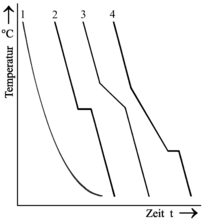Thermal analysis
The thermal analysis is an investigation method for the measurement of physical and chemical properties of elements and compounds . The field of application of thermal analysis includes chemical, pharmaceutical and technical issues.
Classification
In dynamic thermal analysis , the substance to be examined is slowly, i.e. H. in thermodynamic equilibrium , heated or cooled. At the same time, a thermocouple continuously determines the temperature.
The static thermal analysis is used, among other things, in mineralogy . The mineral sample to be examined is brought to a constant temperature for hours or days. During this time, the loss of water or ignition is recorded and recorded.
- In this way, transition points from solid to liquid to gaseous ( melting and boiling point ) can be determined in the event of temperature changes. (see also: physical state )
Alternatively, you can also differentiate based on the changing sizes:
- Energetic processes
- Differential Thermal Analysis (DTA)
- dynamic differential calorimetry (DDK, differential scanning calorimetry , DSC)
- Mechanical processes
- Mass changing operations
- Thermogravimetry (TG)
- Emission gas analysis (EGA, English Evolved Gas Analysis , often coupled to TG)
- Volume change
- Change in optical properties
- thermo-optical analysis (TOA)
In addition, there are methods that combine the above operations. One example is simultaneous thermal analysis (STA), a combination of thermogravimetry (TG) and dynamic differential calorimetry (DSC).
Significance for materials science
Of particular interest in metals , alloys and plastics are the transitions from solid to liquid as well as possible temperature changes in the solid state, since transformations of the crystal system also become noticeable through breakpoints. Crystal system conversions can be used to increase the hardness of metals and alloys.
The measurement results are entered in temperature-time diagrams. The points connected to one another result in the heating and cooling curves.
The cooling curves shown here are, for example, characteristic of amorphous substances (1), a pure element or a eutectic (2), an alloy with mixed crystal formation (3) and a near-eutectic alloy (4). Curves 2, 3 and 4 see also alloy
literature
- DIN 51004 - June 1994: Thermal analysis (TA). Determination of the melting temperatures of crystalline substances with differential thermal analysis (DTA)
- DIN 51005 - August 2005: Thermal analysis (TA) - terms
- DIN 51006 - July 2005: Thermal analysis (TA) - Thermogravimetry (TG) - Basics
- DIN EN ISO 11357-1 - 2009: Plastics - Dynamic differential thermal analysis (DSC) - Part 1: General principles
- DIN 53765 - 1994: Testing of plastics and elastomers; Thermal analysis; Dynamic differential calorimetry (DDK)
- Gabriela Riedel, Gottfried Wilhelm Ehrenstein, Pia Trawiel: Practice of thermal analysis of plastics . Carl Hanser, Munich, ISBN 3-446-22340-1 .
- WF Hemminger, HK Cammenga: Methods of thermal analysis . Springer, Berlin, ISBN 3-540-15049-8 .
- G. Höhne, W. Hemminger, H.-J. Flammersheim: Differential Scanning Calorimetry - An Introduction for Practitioners . Springer, Berlin, ISBN 3-540-59012-9 .
- PJ Haines: Principles of Thermal Analysis and Calorimetry . The Royal Society of Chemistry, 2002, ISBN 0-85404-610-0 .
- JL Ford, P. Timmins: Pharmaceutical Thermal Analysis - Techniques and Applications . Ellis Horwood Limited, 1989, ISBN 0-7458-0346-6 .
- European Pharmacopoeia , Deutscher Apotheker Verlag Stuttgart, 6th edition, 2008, pp. 71-74, ISBN 978-3-7692-3962-1 .
